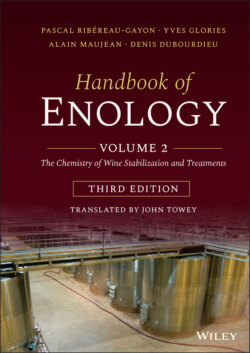Читать книгу Handbook of Enology, Volume 2 - Pascal Ribéreau-Gayon - Страница 60
2.5.1 Ethyl Acetate
ОглавлениеThe most prevalent ester in wine is certainly ethyl acetate. A small quantity is formed by yeast during fermentation, but larger amounts result from the activity of aerobic acetic acid bacteria, especially during aging in oak barrels. Apparently, lactic acid bacteria are not able to produce this ester. Ethyl acetate is responsible for the olfactory characteristics in wines affected by acescence: a solvent‐ or glue‐like odor. These wines also have high volatile acidity, but acetic acid is not only responsible for acescence.
The aroma perception threshold of ethyl acetate is approximately 160 mg/l. Even below this value, while it may not be identifiable, it may spoil wine bouquet with an unpleasant, pungent tang.
Furthermore, ethyl acetate affects the somatosensorial sensations provoked during tasting. At relatively high concentrations (above 120 mg/l) that are still below the aroma perception threshold, it gives red wines a burning sensation, which reinforces the impression of harshness on the aftertaste. Ethyl acetate contributes to hardness and firmness in red wines. From field observations, an acetic acid concentration of at least 0.90 g/l is required to produce a noticeable acrid, sour aftertaste, which is, in fact, due to the mixture of acetic acid and ethyl acetate.
FIGURE 2.8 Biosynthesis mechanism of fatty acids.
